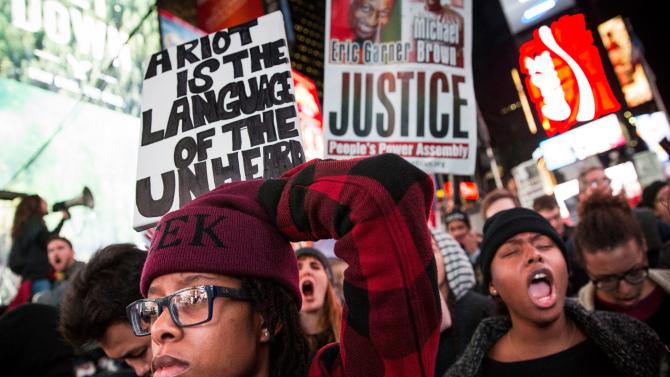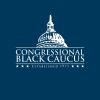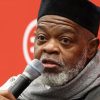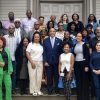By Peniel E. Joseph —
People protest in Times Square Nov. 25, 2014, in New York City over the grand jury decision not to indict then-Officer Darren Wilson in the Michael Brown case in Ferguson, Mo.
This year, 2015—the 50th anniversary of the Voting Rights Act and the 150th anniversary of emancipation and the end of the Civil War—is the time to turn nationwide #BlackLivesMatter protests into tangible public policy.
The Success-Oriented Funding proposal from the Brennan Center for Justice at New York University offers activists a tangible framework for criminal-justice reform. What authors Nicole Fortier and Inimai Chettiar characterize as “Success-Oriented Funding” would dramatically change the way in which federal criminal-justice grants are distributed. Since the 1980s, these grants have provided billions of dollars to states to increase arrests and, thus, the prison population. The Brennan Center’s proposal calls for new federal grant incentives based on reducing the prison population, promoting rehabilitation and curtailing juvenile incarceration.
President Barack Obama could enact these reforms through executive order.
Imagine if #BlackLivesMatter activists—following the Dreamers on immigration reform—made plans to disrupt, lobby, demonstrate and organize in a broad-based effort to compel the Obama administration to sign executive orders that go beyond Attorney General Eric Holder’s well-publicized Department of Justice reform efforts?
For example, what if the young activists who met with Obama this past December forcefully demanded that he sign such an executive order while relaying the relevant policy specifics and potential reverberations in the criminal-justice system? Whether or not Obama eventually signed the order, the movement would be on the offensive, with a clearly detailed policy proposal that many constituencies could rally behind.
So far, though, the notion of ending mass incarceration through executive order has rarely been picked up in the mainstream media.
The movement needs radical, policy-specific proposals that could be enacted at the federal level through executive order, along with parallel state and local proposals that could be developed in coordination with organizations, such as the American Civil Liberties Union, that have been at the forefront of criminal-justice reform efforts.
Confronted by continued and creatively disruptive protests, including the #BlackBrunch demonstrations that have been organized in New York City and Oakland, Calif., many have openly called for the movement to provide concrete demands outlining its policy goals and ambition.
Oprah Winfrey’s recent, and largely misunderstood, comments about wishing to see new leaders capable of articulating a pragmatic vision for change are indicative of the hunger for the #BlackLivesMovement to wed protests to public policy.
A few things are worth unpacking on this score. First, there have been demands, including those coming directly out of Ferguson, Mo., calling for racial and economic justice and the end to mass incarceration. As important as these calls are, however, they don’t offer a specific policy vision that might transform the criminal-justice system and other institutions that continue to marginalize poor black folk.
Second, the call for vertical, or, top-down, leadership, while understandable, ignores the horizontal, grassroots organizing that transformed American democracy during the civil rights era—an era that featured both vertical and horizontal leadership. For every Martin Luther King Jr., there were more Ella Bakers, Fannie Lou Hamers and Stokely Carmichaels who organized at the local level, faced numerous arrests and slept on the floors of sharecroppers’ shacks. They provided the concrete organizing tactics and strategy that facilitated the political mobilization called for by national leaders such as King during the Selma, Ala., voting-rights campaign. The current movement’s young leaders include Brittany Packnett, Ashley Yates, T-Dubb-O, Tef Poe and Phillip Agnew.
Winfrey may not know who they are, but she should—and soon will.
However, Winfrey’s point about articulating specific policy goals is an important intervention. The #BlackLivesMatter movement requires specific policy proposals that, taking into account Washington, D.C.’s political dysfunction, are capable of making a dent in the systemic issues that plague much of the African-American community.
#BlackLivesMatter is easily one of the most profound social-justice movements this country has produced since the civil rights era. Against considerable odds, the movement has managed to maintain the momentum that it gained in the aftermath of the Eric Garner grand jury decision in New York City. But to sustain this momentum, it must now craft specific and detailed policy goals, at the federal, state and local levels, that will connect creative protest and moral passion to game-changing legal and legislative changes.
Demanding that President Obama make it clear where he stands on the question of racial justice in the criminal-justice system is the best place to start.
Peniel E. Joseph, a contributing editor at The Root, is founding director of the Center for the Study of Race and Democracy and a professor of history at Tufts University. He is the author of Waiting ’Til the Midnight Hour: A Narrative History of Black Power in America, Dark Days, Bright Nights: From Black Power to Barack Obama and Stokely: A Life. Follow him on Twitter.















